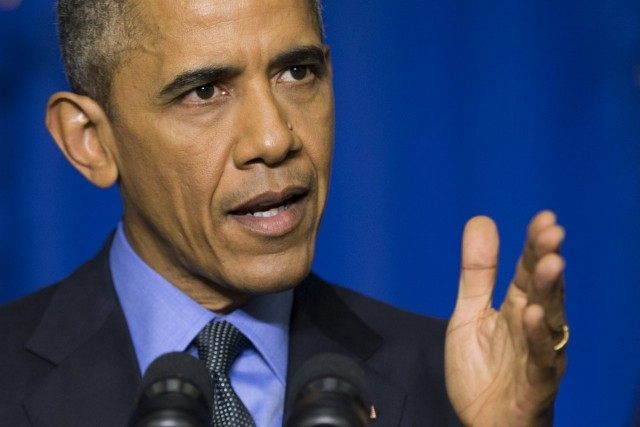President Obama’s controversial Clean Power Plan (CPP) was published in the Federal Register on October 23, 2015. But that is hardly the end of the story. Instead the saga is just beginning—with the ending to be written sometime in 2017 and the outcome highly dependent on who resides in the White House.
The CPP is the newest set of Environmental Protection Agency’s (EPA) regulations designed to be the centerpiece of the Obama administration’s climate-change policy.
Immediately following the rule’s publication, a coalition of 24 states and a coal mining company, led by West Virginia Attorney General Patrick Morrisey (R), filed a lawsuit to challenge CPP. Morrisey called it: “flatly illegal and one of the most aggressive executive branch power grabs we’ve seen in a long time.”
The Hill reports: “They are asking the Court of Appeals for the District of Columbia Circuit to overturn the rule. They also want the court to immediately stop its implementation while it works its way through the courts.” On January 21, 2016, the federal court refused to put a hold on CPP while the litigation proceeds. It did, however, agree to expedite the case with oral arguments beginning on June 2.
Days later, January 26, in an unusual move, the petitioners—which now include 29 states and a large group of utility companies and energy industry trade groups—turned to the Supreme Court (SCOTUS). Morrisey acknowledged: “While we know a stay request to the Supreme Court isn’t typical at this stage of the proceedings, we must pursue this option to mitigate further damage from this rule.”
Citing SCOTUS’ 2015 ruling that reversed the Mercury Air Toxics Standards (MATS) rule, petitioners argued that the damage from MATS had already been done by the time the decision came down. In a Client Alert, international law firm Milbank—which works in the energy space—said: “The EPA itself acknowledged that the ruling had virtually no impact, as states had already largely complied with the regulation by the time the Court’s order was issued.”
Despite the historic nature of the request, on February 9, in a 5 to 4 majority, SCOTUS granted an emergency stay of CPP. The victory means the EPA is prohibited from implementing or enforcing CPP until the D.C. Circuit issues a decision on the challenge—which is expected as early as this fall. FuelFix reports: “The conventional wisdom is the three-member court panel will rule favorably for the White House.”
As 18 states opposed the application for the stay, whatever decision the lower court reaches, most experts agree SCOTUS will eventually hear the case—likely in 2017.
CPP opponents saw the stay as a sign SCOTUS might strike down the rule. Confidence ebbed, however, with the death of Justice Antonin Scalia—just four days after the court’s unprecedented stay order. As a conservative voice on the court, Scalia had a history of limiting government regulation and was a scathing critic of EPA’s regulation of greenhouse gas emissions.
States have reacted differently to the stay. Many states, such as Massachusetts, Arizona, and Virginia are moving ahead with their plans. Some are already well into their CPP compliance plans, with California expected to submit its plan ahead of schedule. Ohio Public Utility Commissioner Asim Haque, reports that they were “already close to completion,” but the commission has put analysis on hold for now.
Because the SCOTUS stay halts enforcement of CPP until the court challenge concludes, and delays the EPA’s deadlines, Morrisey, in a February 12 letter to the National Association of Regulatory Utility Commissioners and the National Association of Clean Air Agencies, encouraged them to “put their pencils down.” The letter point out: states “have no legal obligation to continue with spending taxpayer funds on compliance efforts for a suspended and likely unlawful Power Plan. …Any taxpayer dollars spent during the judicial review process are unnecessary and likely to be entirely wasted.”
With the court challenge coming up in a few months, last week, February 23, led by Senate Majority Leader Mitch McConnell (R-KY), 34 Senators and 171 Representatives filed an amicus brief urging the Circuit Court to “block the EPA’s attempts to transform the nation’s electricity sector.” As the press release states, the lawmakers believe the rule “goes well beyond the clear statutory directive.” It points out: “States will face unprecedented new regulatory burdens, electricity ratepayers will be subject to billions of dollars in compliance costs, and American workers and their families will experience the hardship of job losses due to power plant shutdowns, higher electricity prices, and overall diminishment of the nation’s global economic competitiveness.”
Now, we wait for CPP to make its way through the courts—first the D.C. Circuit Court and then, in 2017, the Supreme Court. But, since CPP is on hold until at least 2017, its future will really be decided by the next president.
With a Republican president, there’ll be many changes that could impact CPP. The EPA, should it not be eliminated, will have a new Administrator. Gina McCarthy will no longer be in charge. If CPP were actually argued before the court, it would be under the guidance of new leadership and could be presented in a very different way.
Since CPP will not be argued in the Supreme Court until 2017, when the next president will be in office, it really is the winner on November 8, 2016, who determines the legal battle of CPP—which will either embrace or eradicate Obama’s climate change policies. Considering CPP will, as Morrisey pleads, cause “even more destruction of untold number of jobs, skyrocketing electricity bills and the weakening of the nation’s electric grid,” the stakes couldn’t be higher.
The author of Energy Freedom, Marita Noon serves as the executive director for Energy Makes America Great Inc., and the companion educational organization, the Citizens’ Alliance for Responsible Energy (CARE). She hosts a weekly radio program: America’s Voice for Energy—which expands on the content of her weekly column. Follow her @EnergyRabbit.

COMMENTS
Please let us know if you're having issues with commenting.